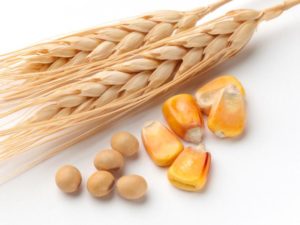 Grain futures were mixed on Thursday with wheat gaining, while corn and soybeans continued to decline due to ample supply forecasts.
Grain futures were mixed on Thursday with wheat gaining, while corn and soybeans continued to decline due to ample supply forecasts.
On the Chicago Board of Trade, wheat futures for September delivery traded at $6.6588 a bushel at 9:47 GMT, up 0.13% on the day. Prices ranged between days high at $6.6738, the highest since July 17, and days low of $6.6275 a bushel. The grain gained 1.41% on Wednesday, a fourth consecutive daily advance, and extended this weeks surge to over 2.5% after plunging 4.7% the preceding two.
Wheat was recently well supported as lower prices led to an increase in demand as some countries began to refill stockpiles. The grain advanced 1% in July, which was the first monthly gain since April.
Japan bought 89 579 tons of western-white wheat from the U.S. today, the first purchase after lifting a two-month suspension on Oregon white wheat as an unauthorized genetically modified strain was detected growing in Oregon.
Sunao Orihara, director for grain trade and operation at the Ministry of Agriculture, Forestry and Fisheries, said that Japan has now established a system to detect the unapproved strain before shipment from the U.S. The health ministry will also test the imported grain upon arrival. The total amount of inspected wheat for export at U.S. ports rose by 4.9% the last week, indicating surging demand.
The resumption of U.S. wheat imports eased concern over short supply in Japan, which imports 90% of the wheat it needs and 60% of total food. Japan already purchased earlier in the month 23 963 tons of club wheat grown in Washington state, 1,497 tons of Australian premium-white and 1,710 tons of U.S. soft-red winter.
Yesterday, Egypt, the world’s largest wheat importer, made a fourth purchase this month, ordering 240 000 tons from suppliers in Romania and Ukraine.
The USDA said in its weekly crop progress report on Monday that heading of the spring wheat crop advanced by 9% to 94% as of last week, below the five-year average of 95% and last year’s 99% during the comparable week. Crop condition was overall better compared to last season. As of July 28, 6% of the crop was rated very poor-poor, compared to 11% a year earlier. Results in the “Fair” category were equal at 26% and as for the premium quality, 68% was categorized as “Good” and “Excellent”, above 2012′s 63%.
Corn with minor decline
Corn swung between gains and losses on Thursday and continued to trade overall lower as weather forecasts kept pointing at favorable conditions for both corn and soybeans developing. Forecaster DTN said in a report yesterday that cool weather across the U.S. within the next 10 days will support corn pollination, while rains in the Midwest will aid pod-filling soybeans.
Luke Mathews, a commodity strategist at Commonwealth Bank of Australia, wrote in a report today: “Continued cool temperatures across most of the U.S. Corn Belt are also leading to very strong U.S. production prospect. Ongoing excellent North American production prospects remain bearish for soybeans.”
Corn fell 6.3% in July, marking a sixth consecutive monthly decline, the worst run since 1996. The grain has fallen 32% so far this year, underperforming the Standard & Poor’s GSCI Index of eight agricultural commodities, which lost 17%. The USDA trimmed its latest corn crop output forecast to 13.95 billion bushels, down from 14.005 billion, but that was however still an all-time record high and is 29% higher than last year’s drought damaged crop. This year’s global stockpiles are projected to rise to 150.97 million tons by the end of the 2013-2014 marketing year, 22% more than the previous period.
On the Chicago Board of Trade, corn futures for September delivery traded at $4.9813 a bushel at 9:47 GMT, down 0.22% on the day. Prices ranged between days high at $4.9975 and low of $4.9775 a bushel respectively. The grain gained 0.76% on Wednesday and has so far advanced 1.3% on the week as lower prices lured back market players. The September contract plunged 9.48% the preceding week.
As for the corn condition, the crop was of the same quality like a week before but a lot better than last year’s drought damaged crop. As of July 28, 11% was categorized as “Very poor” and “Poor”, well below 2012′s 48%. Meanwhile, 26% of the crop fell in the “Fair” category compared to 28% a year earlier. As for the premium quality, 63% was rated good-excellent, well above last year’s 24% during the comparable week.
Soybeans slightly fall
Soybeans marked a minor loss on Thursday and continued to trade near the lowest level since February 2012 as favorable weather conditions in key U.S. growing areas assured a record-high crop. Soybeans for September delivery traded at $12.4875 a bushel at 9:49 GMT, down 0.05% on the day. Prices held in range between days high and low of $12.5225 and $12.4375 a bushel respectively. The oilseed fell to $12.3750 a bushel on Wednesday, the lowest since February 2012, as weather conditions continued to benefit crop developing. The September contract is marking a 7.5% weekly decline so far after plunging 9.39% the preceding week.
Soybeans fell 3.7% in July, marking a second monthly decline in a row. The oilseed has lost 14% so far this year as the USDA projected domestic output will jump to a record 3.42 billion bushels, which would boost global inventories by 20% to an all-time record high of 74.1 million tons. Goldman Sachs’s 12-month price estimate for soybeans remained at $11 per bushel last week.
The USDA said soybeans condition was almost the same compared to the preceding week and far better than last year’s quality. As of July 28, 9% of the crop was rated very poor-poor, compared to 37% in 2012. Meanwhile, 28% of soybeans were categorized as “Fair”, below last year’s 34%. As for the premium quality, 63% of the crop was rated good-excellent, compared to 29% during the comparable week in 2012.





